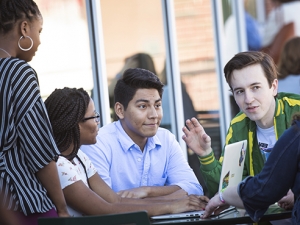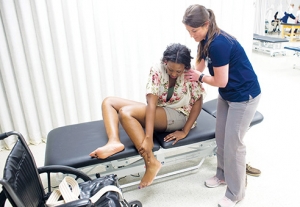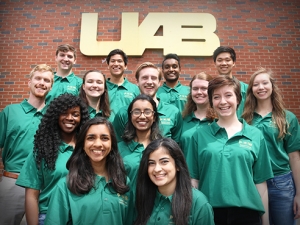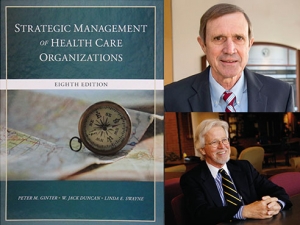Two handsful of faculty saved students more than $269,000 for texts and other class materials during the spring semester. And they are back at it again.
Affordable Instructional Materials grants, awarded by UAB Center for Teaching and Learning and funded in partnership with the UAB Bookstore, were awarded to 10 faculty in psychology, chemistry, English, biology, public health and business for the spring semester. That group continued its work this fall, and the CTL plans to add 20 more faculty for the spring 2018 semester.
Faculty received a $1,000 professional development stipend to propose and implement a plan to reduce the amount of money their students spend on textbooks and other instructional materials for one of their courses. Their approaches were varied: Some created their own online resources in Canvas, while others looked into using rental textbooks or older editions.
Meet four of the faculty who came up with creative ways to save each of their students an average $113 on course materials for their class.
Customizing chemistry
Mitzy Erdmann, Ph.D., chemistry instructor
Erdmann began her undergraduate career at Loyola University as a music major before switching to chemistry — both degree programs with notoriously high textbook costs. She got a job at the campus bookstore so she could rent her books, but always angled to get them free when she could.
“It was somewhat soul-crushing,” Erdmann said. “I’d try to sucker the publishers to give them to me when I did orders over the phone.”
Erdmann, who received her master’s and doctorate degrees at UAB, said she saw similar responses to the cost of chemistry books from students in her classes, and the AIM grant let her make some changes.
Erdmann already was using a customized lab manual, but its cost had slowly increased over time. She realized that plan was no longer saving students much money, so she began making materials available online and created instructional videos with the help of undergraduate assistants Cat Black and Sophie McVicar.
|
“If you don’t watch carefully, the price of textbooks creeps up relatively quickly.” |
“If you don’t watch carefully, the price creeps up relatively quickly,” Erdmann said. “When we started publishing, we didn’t have Canvas.”
Ultimately, Erdmann saved 1,500 students more than $180,000 in the span of two semesters. By developing original materials and using online resources in Canvas, she reduced the per-student cost to $30 for both semesters of her chemistry course.
The consolidation enables students to keep all their work in one notebook for two semesters and provides more pages for note-taking, which students like, Erdmann said.
“They used to have to buy a new lab manual to have more pages, so we were able to better their lab note-taking,” Erdmann said. “We’re making little scientists.”
Going paperless
Jacqueline Nikles, Ph.D., associate professor of chemistry
When Nikles was assigning a chemistry lab manual to her students, she said she estimated the cost to be around $50. However, she didn’t realize the cost had increased to almost $75 during the course of a few semesters. That, combined with problems with the manual, such as irrelevant experiments, incorrect glassware setups and procedural description issues, inspired Nikles to create her own materials to save students money and give them a more fulfilling lab experience.
“I had been growling about the lab manual for a long time,” Nikles said. “When the AIM initiative started, I thought, ‘This is the thing that will finally push me to do this.’”
|
“I had been growling about the lab manual for a long time. When the AIM initiative started, I thought, ‘This is the thing that will finally push me to do this.’” |
Nikles also worked with Ryan Murphy, a student in the Chemistry Scholars Program, to make instructional and explanatory videos students could watch in Canvas. In total, she saved 344 students more than $15,400 by creating digital materials students could access for free using Canvas. Plus, with videos and class materials online, Nikles said her students have essentially gone paperless.
“Textbooks are expensive, and what we used was on the cheap end,” Nikles said. “Organic chemistry textbooks can run up to $250. If a student buys a cheaper loose-leaf version of a textbook, they wouldn’t even be able to sell it.”
Back to basics
Dale A. Dickinson, Ph.D., associate professor of public health
With two kids enrolled as students at UAB, Dickinson is no stranger to the high cost of textbooks. When he applied for the AIM grant, he already had been investigating cheaper textbook options for his public health courses and discovered that some older editions of textbooks he used were available online through the publisher — completely for free.
“It’s definitely something I’m aware of as a parent — this is expensive,” Dickinson, who also is director of UAB’s Quality Enhancement Plan, said. “But there are ways we can rather simply get around that.”
In Dickinson’s toxicology class, for example, he started using an earlier edition of the textbook, which was available online as a PDF. Dickinson made it available for download through Canvas. In all, he saved 84 students more than $7,000 per semester by adapting no-cost, digital course materials to replace high-cost textbooks.
|
“Some ask, ‘What do you mean there’s nothing required? I tell them, ‘Trust me, there’s a lot of reading. There’s just no physical textbook.” |
“If I was using this book for a doctoral class, I’d probably use the newest one, but for an undergraduate course, I can use an older edition because the basics haven’t changed, and I can give to them for free as a PDF, which they can search to find information easier.”
Dickinson said that, somewhat surprisingly, some students are so accustomed to physical textbooks in the collegiate learning model they were reticent to enroll in a class where there are “no materials needed.”
“Some ask, ‘What do you mean there’s nothing required?’” Dickinson said. “I tell them, ‘Trust me, there’s a lot of reading. There’s just no physical textbook.”
Enriching the experience
Samiksha Raut, Ph.D., assistant professor of biology
When Raut’s husband decided to pursue an MBA, she was surprised at the high cost of his textbooks. When she discovered the AIM grant, she knew she had to apply.
“I was pretty blind to how much students end up paying,” she said. “When I saw this initiative, I just jumped on it.”
Raut saved 81 students more than $9,500 this semester by working directly with the textbook publisher to create more affordable versions of lecture course materials. The course in which she changed the textbook was for non-biology majors, and students were spending close to $200 on books for the lecture alone.
The publisher allowed Raut to hand-pick chapters from the primary textbook and consolidate them into a smaller, less expensive e-book version. To enrich the class experience, she also incorporated guest lectures from scientists and physicians and incorporated a service-learning component through the Office of Service Learning and Undergraduate Research.
On the first day of class, Raut revealed to her students that the lab manual was only going to cost $23 for the semester, and said many of them were shocked.
|
“I think each and every professor should look into this. It can save a lot of money for students who are living off student loans.” |
“Some of them were left in great disbelief,” she said. “They were like, ‘Really? My other professors have always asked me to spend more than $200, and I don’t have scholarships.’”
Raut said her main priority was doing what was best for her students and helping them have the best learning environment — and she didn’t compromise either of those in finding more affordable options for textbooks.
“I think each and every professor should look into this,” she said. “It can save a lot of money for students who are living off student loans.”









